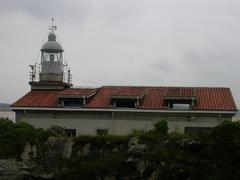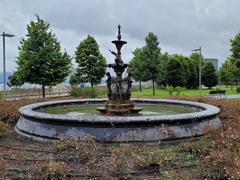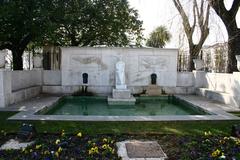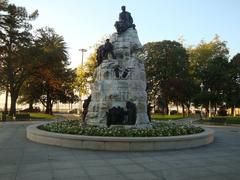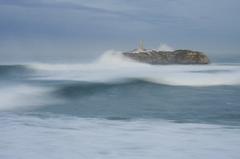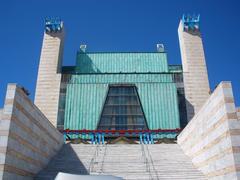
Estadio El Sardinero: Visiting Hours, Tickets, and Complete Guide to Santander’s Historic Stadium
Date: 04/07/2025
Introduction
Estadio El Sardinero rises above the picturesque El Sardinero district in Santander, Spain, as a symbol of the city’s sporting tradition, architectural evolution, and vibrant coastal culture. Home to Real Racing Club de Santander since 1913, the stadium has transformed from a humble wooden stand into a contemporary arena that seats over 22,000 fans. With its proximity to the Cantabrian Sea and Santanders iconic beaches, it is both a sports hub and a scenic landmark. Beyond football, El Sardinero hosts community events and cultural gatherings, weaving itself into the daily life and identity of the city. This detailed guide covers its history, architecture, visiting hours, ticketing, accessibility, nearby attractions, and practical visitor tips, ensuring you get the most from your experience at this Cantabrian icon (lasoga.org; StadiumDB; bstadium.es).
Table of Contents
- Historical Overview
- Stadium Architecture & Facilities
- Visiting Information
- Matchday Experience
- Nearby Attractions
- Practical Visitor Tips
- Cultural Significance
- Frequently Asked Questions (FAQ)
- Summary & Visitor Tips
- References
Historical Overview
Early Foundations (1913–1930s)
Real Racing Club de Santander was founded in 1913, and soon after, the original Estadio El Sardinero opened its doors. The opening match, a defeat against Gimnástica de Torrelavega, marked the start of a new era for football in Santander (lasoga.org; fcscout.com). By 1916, a 30-meter wooden grandstand and directors’ box reflected the club’s ambition. The stadium’s coastal location, near the beaches and the Cantabrian Sea, helped cement its character and local importance (secretattractions.com).
During the 1920s, Racing’s growing stature led to expanded stands and capacity. A historic milestone came on April 17, 1927, when the stadium hosted its first international match—Spain defeated Switzerland 1–0 (lasoga.org). Racing was then among the ten founding clubs of La Liga (fcscout.com).
Architectural Evolution & Renovations
Post-war decades brought significant changes. Racing purchased the stadium in 1954, and a major 1961 renovation introduced a striking concrete grandstand with a wave-inspired roof, echoing the nearby sea (lasoga.org). Floodlights were installed in 1963 for evening matches, and the field was expanded.
The approach of the 1982 FIFA World Cup prompted further upgrades, but El Sardinero ultimately did not host World Cup games. In 1983, the stadium was sold to the city, and by 1988, the old ground was demolished. The new stadium, Campos de Sport de El Sardinero, opened just 150 meters away from the original site (espanaestadios.com).
Modern Era (1988–Present)
Inaugurated in August 1988, the modern Estadio El Sardinero was designed by Juan José Arenas. Today, it is Cantabria’s largest stadium, with a capacity of 22,308 as of 2025 (StadiumDB). The stadium has continued to evolve, with recent enhancements focused on sustainability, including plans for vertical gardens on its façade (stadiumdb.com).
Stadium Architecture & Facilities
El Sardinero features a rectangular, football-specific layout with four stands enclosing the pitch. The main west stand is elevated and includes two tiers and skyboxes. The other stands combine green and white seating, mirroring Racing’s colors (Centrocampista). The stadium’s roof covers all stands except the first rows, providing shelter and ensuring natural light and ventilation.
Modern amenities include VIP areas, skyboxes, and two massive electronic scoreboards updated in 2017 (MuseWiki). The stadium is adjacent to the Palacio de Deportes de Santander, expanding its role as a cultural and sporting hub.
Visiting Information
Hours & Ticketing
- Matchdays: Gates open 1–2 hours before kickoff.
- Guided Tours: Generally available Tuesday to Sunday, 10:00–18:00. Hours may vary on matchdays or during special events (bstadium.es; Tiqets).
- Tickets: Match tickets range from €15–€40. Guided tour tickets start at €8–€15, with discounts for children, seniors, and groups. Tickets are available at the stadium box office and online (official club website; Tiqets; Taquilla).
Guided Tours
The official Tour Interactivo El Sardinero grants behind-the-scenes access to:
- Press room
- Locker rooms
- Presidential box and VIP lounges
- Pitchside and dugouts
- Club museum
- A virtual reality experience simulating a matchday entrance (bstadium.es)
Tours last around 1 hour, are primarily in Spanish (some guides offer English), and group sizes are limited for a personalized feel. Booking in advance is recommended.
Accessibility
The stadium is accessible for visitors with reduced mobility, with dedicated seating, ramps, elevators, and adapted restrooms. Notify the club in advance for special assistance (Tiqets).
Getting There
- By Public Transport: Santander city buses (lines 1, 2, 13) serve the stadium; the main train station is a short taxi or bus ride away.
- By Car: Parking is available nearby but fills quickly on matchdays (guias-viajar.com).
- Walking/Biking: The stadium is within walking distance from El Sardinero beaches and hotels.
Matchday Experience
Matchdays bring the stadium alive with the chants of the “Curva Norte” and “Curva Sur.” The local fanbase creates a family-friendly, electric atmosphere. Food kiosks serve snacks and local specialties such as “rabas” (fried squid rings). Merchandise is available at the official club shop. It is advisable to buy tickets in advance for high-profile fixtures.
Nearby Attractions
- El Sardinero Beaches: Just a short walk away, perfect for pre- or post-visit relaxation (Thrillophilia).
- Gran Casino Sardinero: Historic Belle Époque building.
- Jardines de Piquío: Lush gardens between the main beaches.
- Palacio de la Magdalena: Former royal residence nearby (guias-viajar.com).
- Hotels and Restaurants: Gran Hotel Sardinero, Hotel Santemar, and local seafood eateries abound (The Travel Tortoise).
Practical Visitor Tips
- Best Time to Visit: Football season (August–May) for matches, summer (June–September) for combining with beach visits.
- Language: Spanish is predominant; limited English available on tours.
- Weather: Expect rain and mild temperatures. Dress accordingly.
- Photography: Allowed in most areas; professional cameras may need accreditation on matchdays.
- Safety: The district is safe, with enhanced security on matchdays.
Cultural Significance
Estadio El Sardinero is a pillar of Santander’s sporting identity and community pride. It has hosted historic football matches, international fixtures, and key cultural events. The stadium’s continued modernization and its integration with the city’s beaches and landmarks underscore its unique place in Cantabrian culture (en.wikipedia.org; guias-viajar.com).
Frequently Asked Questions (FAQ)
Q: What are the stadium’s visiting hours?
A: Tours typically run Tuesday–Sunday, 10:00–18:00; hours may change on matchdays. Check the official website for current details.
Q: How do I buy tickets?
A: Via the official club site, ticket platforms (Tiqets, Taquilla), or at the box office.
Q: Is the stadium accessible?
A: Yes; accessible seating, ramps, elevators, and restrooms are provided.
Q: Are there tours in English?
A: Tours are primarily in Spanish; request English when booking.
Q: Can I take photos?
A: Yes, except in restricted areas; professional photography requires accreditation on matchdays.
Q: What attractions are nearby?
A: El Sardinero beaches, Gran Casino, Jardines de Piquío, and the Palacio de la Magdalena.
Summary & Visitor Tips
Estadio El Sardinero is more than a football venue—it is a living testament to Santander’s sporting history, architectural innovation, and community spirit. Whether you’re joining a match, taking a guided tour, or exploring the neighboring beaches and landmarks, the stadium offers a unique window into Cantabria’s culture. For the latest on visiting hours, tickets, and events, consult the official Real Racing Club de Santander website and Santander’s tourism portal. Book ahead, arrive early, and immerse yourself in the city’s vibrant coastal life (StadiumDB; lasoga.org; bstadium.es).
References and Further Reading
- lasoga.org
- StadiumDB
- bstadium.es
- Tiqets
- Wikipedia
- The Travel Tortoise
- Secret Attractions
- FC Scout
- guias-viajar.com
- Tomaticket
- Taquilla
- Thrillophilia
- MovetoSpain.es



